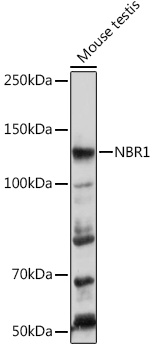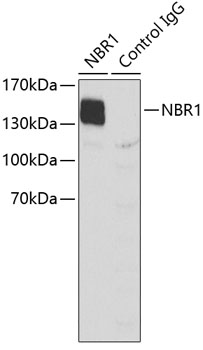Anti-NBR1 Antibody (CAB3949)
- SKU:
- CAB3949
- Product type:
- Antibody
- Reactivity:
- Human
- Reactivity:
- Mouse
- Reactivity:
- Rat
- Reactivity:
- Monkey
- Host Species:
- Rabbit
- Isotype:
- IgG
- Research Area:
- Cell Biology
Frequently bought together:
Description
| 抗体名: | Anti-NBR1 Antibody |
| 抗体コード: | CAB3949 |
| 抗体サイズ: | 20uL, 50uL, 100uL |
| 申し込み: | WB IHC IF IP |
| 反応性: | Human, Mouse, Rat, Monkey |
| 宿主種: | Rabbit |
| 免疫原: | Recombinant protein of human NBR1 |
| 申し込み: | WB IHC IF IP |
| 推奨希釈: | WB 1:500 - 1:2000 IHC 1:50 - 1:200 IF 1:50 - 1:100 IP 1:20 - 1:50 |
| 反応性: | Human, Mouse, Rat, Monkey |
| ポジティブサンプル: | Mouse testis |
| 免疫原: | Recombinant protein of human NBR1 |
| 精製方法: | Affinity purification |
| ストレージバッファ: | Store at -20'C. Avoid freeze / thaw cycles. Buffer: PBS with 0.02% sodium azide, 50% glycerol, pH7.3. |
| アイソタイプ: | IgG |
| 順序: | Email for sequence |
| 遺伝子ID: | 4077 |
| Uniprot: | Q14596 |
| セルラーロケーション: | Cytoplasm, Cytoplasmic vesicle, Lysosome, M line, autophagosome, myofibril, sarcomere |
| 計算された分子量: | 103kDa/107kDa |
| 観察された分子量: | 120KDa |
| 同義語: | NBR1, 1A1-3B, IAI3B, M17S2, MIG19 |
| バックグラウンド: | The protein encoded by this gene was originally identified as an ovarian tumor antigen monitored in ovarian cancer. The encoded protein contains a B-box/coiled-coil motif, which is present in many genes with transformation potential. It functions as a specific autophagy receptor for the selective autophagic degradation of peroxisomes by forming intracellular inclusions with ubiquitylated autophagic substrates. This gene is located on a region of chromosome 17q21.1 that is in close proximity to the BRCA1 tumor suppressor gene. Alternative splicing of this gene results in multiple transcript variants. |
| UniProt Protein Function: | NBR1: Acts probably as a receptor for selective autophagosomal degradation of ubiquitinated targets. Homooligomer and heterooligomer. Interacts with TRIM55. Interacts with SQSTM1, titin/TTN, RNF29, USP8, SQSTM1, MAP1LC3A, MAP1LC3B, MAP1LC3C, GABARAP, GABARAPL1 and GABARAPL2. Binds to ubiquitin and ubiquitinated proteins. 2 isoforms of the human protein are produced by alternative splicing. |
| UniProt Protein Details: | Protein type:Ubiquitin conjugating system Chromosomal Location of Human Ortholog: 17q21.31 Cellular Component: membrane; lysosome; late endosome; M band; autophagic vacuole; cytoplasmic vesicle; cytosol Molecular Function:ubiquitin binding; protein binding; zinc ion binding; mitogen-activated protein kinase binding Biological Process: regulation of stress-activated MAPK cascade; macroautophagy; negative regulation of osteoblast differentiation; regulation of bone mineralization; protein oligomerization |
| NCBI Summary: | The protein encoded by this gene was originally identified as an ovarian tumor antigen monitored in ovarian cancer. The encoded protein contains a B-box/coiled-coil motif, which is present in many genes with transformation potential. It functions as a specific autophagy receptor for the selective autophagic degradation of peroxisomes by forming intracellular inclusions with ubiquitylated autophagic substrates. This gene is located on a region of chromosome 17q21.1 that is in close proximity to the BRCA1 tumor suppressor gene. Alternative splicing of this gene results in multiple transcript variants. [provided by RefSeq, Apr 2014] |
| UniProt Code: | Q14596 |
| NCBI GenInfo Identifier: | 296439290 |
| NCBI Gene ID: | 4077 |
| NCBI Accession: | Q14596.3 |
| UniProt Related Accession: | Q14596 |
| Molecular Weight: | 103kDa; 107kDa |
| NCBI Full Name: | Next to BRCA1 gene 1 protein |
| NCBI Synonym Full Names: | NBR1 autophagy cargo receptor |
| NCBI Official Symbol: | NBR1 |
| NCBI Official Synonym Symbols: | IAI3B; M17S2; MIG19; 1A1-3B |
| NCBI Protein Information: | next to BRCA1 gene 1 protein |
| UniProt Protein Name: | Next to BRCA1 gene 1 protein |
| UniProt Synonym Protein Names: | Cell migration-inducing gene 19 protein; Membrane component chromosome 17 surface marker 2; Neighbor of BRCA1 gene 1 protein; Protein 1A1-3B |
| Protein Family: | Next to BRCA1 gene 1 protein |
| UniProt Gene Name: | NBR1 |
| UniProt Entry Name: | NBR1_HUMAN |
View AllClose




